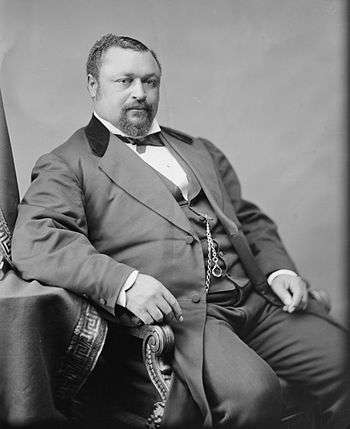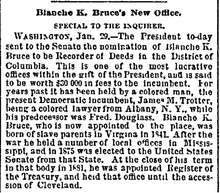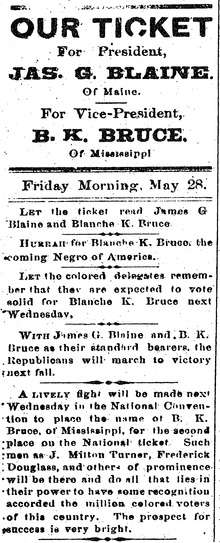Blanche Bruce
| Blanche Bruce | |
|---|---|
 | |
| United States Senator from Mississippi | |
|
In office March 4, 1875 – March 3, 1881 | |
| Preceded by | Henry R. Pease |
| Succeeded by | James Z. George |
| Personal details | |
| Born |
Blanche Kelso Bruce March 1, 1841 Farmville, Virginia, U.S. |
| Died |
March 17, 1898 (aged 57) Washington, D.C., U.S. |
| Political party | Republican |
| Spouse(s) | Josephine Willson Bruce |
| Profession | Politician, teacher, farmer |
Blanche Kelso Bruce (March 1, 1841 – March 17, 1898) was a U.S. politician who represented Mississippi as a Republican in the U.S. Senate from 1875 to 1881; of mixed race, he was the first elected black senator to serve a full term. Hiram R. Revels, also of Mississippi, was the first African American to serve in the U.S. Senate, but did not serve a full term.
Life and Politics

Bruce was born into slavery in 1841 in Prince Edward County, Virginia near Farmville to Polly Bruce, an enslaved African-American woman who served as a domestic slave. His father was her master, Pettis Perkinson, a white Virginia planter. Bruce was treated comparatively well by his father, who educated him together with a legitimate half-brother. When Blanche Bruce was young, he played with his half-brother. His father legally freed Blanche and arranged for an apprenticeship so he could learn a trade.[1]

Bruce taught school and attended Oberlin College in Ohio for two years. He next worked as a steamboat porter on the Mississippi River. In 1864, he moved to Hannibal, Missouri, where he established a school for black children.
In 1868, during Reconstruction, Bruce moved to Bolivar, Mississippi and bought a plantation.[2] He became a wealthy landowner of several thousand acres in the Mississippi Delta. He was appointed to the positions of Tallahatchie County registrar of voters and tax assessor before winning an election for sheriff in Bolivar County.[3] He later was elected to other county positions, including tax collector and supervisor of education, while he also edited a local newspaper. He became sergeant-at-arms for the Mississippi state senate in 1870.[2]
In February 1874, Bruce was elected by the state legislature to the Senate as a Republican, becoming the second African American to serve in the upper house of Congress. On February 14, 1879, Bruce presided over the U.S. Senate, becoming the first African American (and the only former slave) to do so.[1] In 1880, James Z. George was elected to succeed Bruce.
At the 1880 Republican National Convention in Chicago, Bruce became the first African American to win any votes for national office at a major party's nominating convention, winning 8 votes for vice president. The presidential nominee that year was James A. Garfield, who won election.

In 1881, Bruce was appointed by President Garfield to be the Register of the Treasury, becoming the first African American to have his signature featured on U.S. paper currency.[4]
Bruce was appointed as the District of Columbia recorder of deeds in 1890–93, which was expected to yield fees of up to $30,000 per year.[5] He also served on the District of Columbia Board of Trustees of Public Schools from 1892-95.[6] He was appointed as Register of the Treasury a second time in 1897 by President William McKinley and served until his death in 1898.
Relationship with other African Americans
On the Bruce plantation in Mississippi, black sharecroppers lived in "flimsy wooden shacks," working in the same oppressive conditions as on white-owned estates.[7]
After his Senate term expired, Bruce remained in Washington, D.C., where he secured a succession of Republican patronage jobs and stumped for Republican candidates across the country. There, he also acquired a large townhouse and summer home, and presided over black high society.[7]
One newspaper wrote that Bruce did not approve of the phrase "colored men." He often said, "I am a Negro and proud of it."[2]
Marriage and Family
On June 24, 1878, Bruce married Josephine Beal Willson (1853–February 15, 1923), a fair-skinned socialite of Cleveland, Ohio amid great publicity; the couple traveled to Europe for a four-month honeymoon.
Their only child, Roscoe Conkling Bruce was born in 1879. He was named for New York Senator Roscoe Conkling, Bruce's mentor in the Senate. In 2002, scholar Molefi Kete Asante listed Blanche Bruce on his list of 100 Greatest African Americans.[8]
In the fall of 1899, Josephine, accepted the position of Lady Principal at Tuskegee.[9] While visiting Josephine at Tuskegee, during the summer break of his senior year at Harvard, Roscoe won a fan in Booker T. Washington and secured a position at Tuskegee as head of the Academic Department.[9]
Honors and Legacy
In July 1898, the Board of Trustees of Public Schools of the District of Columbia ordered that a then new public school building on Marshall Street be named the Bruce School in his honor.[10] Marshall Street later became Kenyon Street and the Bruce School became Caesar Chavez Prep Middle School in 2009. The name is still used as the Bruce School was combined with the James Monroe school to create Bruce-Monroe, located on Capitol Hill.
See also
References
- 1 2 Glass, Andrew (February 14, 2008). "Freed slave presides over Senate: February 14, 1879". The Politico.
- 1 2 3 Wright, John Aaron (2002). Discovering African American St. Louis: A Guide to Historic Sites. St. Louis, Missouri: Missouri History Museum.
- ↑ Rev. William J. Simmons, Men of Mark: Eminent, Progressive, and Rising, 1887. Pgs. 699-703. Geo. M. Rewell & Co., 1887
- ↑ Turkel, Stanley (2005). Heroes of the American Reconstruction: Profiles of Sixteen Educators, Politicians and Activists. Jefferson, NC: McFarland & Company. p. 6. ISBN 0-7864-1943-1.
Senator Bruce was also the first African-American to preside over the Senate and the first African-American whose signature appeared on all the nation's paper currency (as Register of the Treasury starting on May 18, 1881)
- ↑ "Blanche K. Bruce's New Office", Philadelphia Inquirer, January 1, 1890, page 1.
- ↑ The Executive Documents of the House of Representatives for the third session of the fifty-third Congress 1894-1895. Government Printing Office. 1895. p. 819. Retrieved 16 September 2016.
- 1 2 "Rise and Fall of the House of Bruce". July 2, 2006.
- ↑ Asante, Molefi Kete (2002). 100 Greatest African Americans: A Biographical Encyclopedia. Amherst, New York: Prometheus Books. ISBN 1-57392-963-8.
- 1 2 "Roscoe Conkling Bruce and the District of Columbia's Public Schools, 1906 to 1921".
- ↑ Annual Report of the Commissioners of the District of Columbia for the year ended June 30, 1899. Government Printing Office. 1899. p. 36.
Bibliography
- Graham, Lawrence Otis (2006). The Senator and the Socialite: The True Story of America's First Black Dynasty. New York: Harper Collins. ISBN 978-0-06-098513-4.
- Rabinowitz, Howard N., ed. Southern Black Leaders of the Reconstruction Era (1982), pp 1–38.
External links
- United States Congress. "Blanche Bruce (id: B000968)". Biographical Directory of the United States Congress. Retrieved on 2009-03-26
- "Blanche Bruce". Find a Grave. Retrieved 2009-03-26.
- Biography and Joe Kelso.Tripod
- Review of The Senator and the Socialite
| United States Senate | ||
|---|---|---|
| Preceded by Henry R. Pease |
U.S. Senator (Class 1) from Mississippi March 4, 1875 – March 3, 1881 Served alongside: James L. Alcorn and Lucius Q. C. Lamar |
Succeeded by James Z. George |
| Political offices | ||
|---|---|---|
| Preceded by Glenni William Scofield |
Register of the Treasury May 21, 1881 to June 5, 1885 |
Succeeded by William Starke Rosecrans |
| Preceded by James Fount Tillman |
Register of the Treasury December 3, 1897 to March 17, 1898 |
Succeeded by Judson Whitlocke Lyons |
| Class 1 |  | |
|---|---|---|
| Class 2 | ||